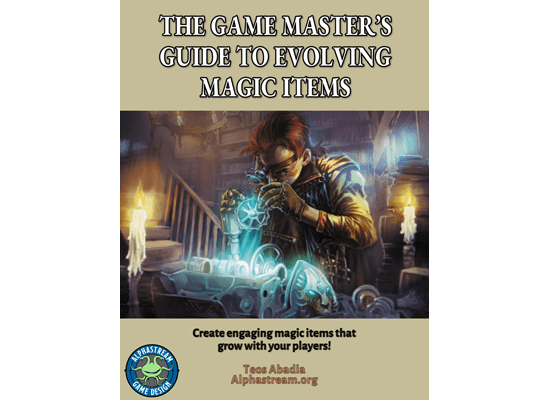Why Classic Adventures Offer Characters Meaningless Death
Classic D&D adventures often have situations that force a quick and meaningless death. Modern editions are often accused of being too easy. Why has the game changed, and what is the point of character death today?
Reviewing the Classics
On the Mastering Dungeons podcast, Shawn Merwin and I are reviewing classic adventures from previous editions (so far: The Village of Hommlet, Pharaoh, Against the Cult of the Reptile God, Dragonlance’s Dragons of Despair, and Isle of Dread). These adventures have some excellent design worth emulating, and some terrible design worth avoiding.
Shawn noticed that several of the adventures pose situations where a character may choose to do something that seems safe… but results in certain death or a chance at certain death. For example, Isle of Dread has a dungeon where parts are flooded. In some rooms, opening the door causes water to move into or out of the room, and this can push the characters around. That’s a really cool concept. But in at least two cases, it sweeps one or more characters to their doom or provides them only a percentage chance to avoid plunging into certain death. There is no way to know the result of your actions beforehand.
My “favorite” example of this may be Hall of the Fire Giant King. In the kitchen is a chute, 6’ in diameter. There are any number of adventures where exploring this could unlock some secret treasure. But in this particular case, it is a greased garbage chute that drops any explorer into a pool of lava. No damage is noted… it’s a pool of lava. If you explore the chute, you die.
Then there was my character, Ferdinand II (I don’t recall what happened to Ferdinand I). Ferdinand the wizard found a magical tome. Yay! I opened it and read the first line. I was the wrong alignment, so the book dealt damage to me… enough to kill me. In an act of defiance, I immediately created Ferdinand III. (I don’t recall how Ferdinand III died – I’m sure it was just as bad.)
From Full to Zero
Instant death can come in many forms. I was playing my beloved monk, Weary Fox, in a 3E organized play adventure and an umber hulk broke through the wall and attacked me. I had all of my hit points when it rolled the first attack, and I was at -10 and dead when it was done.
A year later and my dwarven ranger is walking down a corridor, checking for tracks and traps. There is a spell trap, which can’t be found. It fires three rays at me, each draining levels. The DM rolls high. I’m a 15th level ranger one second, and irrecoverably dead the next. (Okay, we did spend an incredible amount of gold on a true resurrection spell.)
And then there was a 3E organized play special mission I was DMing. In the encounter, an assassin begins hidden. Three rounds later, it strikes a random character, the wizard, killing them outright. From full to zero. I will never forget the demoralized face of that player.
Why D&D Has a Legacy of Meaningless Death
When I played the Original D&D edition prior to the launch of 5E, I remarked how simple the game was (for example, every weapon dealt 1d6 damage). It was also deadly. Any room could spell doom not just for one character, but for the entire party! The high mortality encouraged clever play (like forcing our mules to run into a room with trolls), but there was no way to truly avoid a meaningless death. A giant spider has a poison bite… save or die. A wandering monster table tells us we can encounter 1-100 nixies. 100? No wonder I have a binder full of dead characters.
OD&D was more of a skirmish game with some exploration, rather than what we think of as an RPG today. And this remained largely true through much of the Basic and AD&D editions. Second edition (and later parts of Basic/BECMI) begin to add a number of design complexities to allow characters to have more meaning, capturing that investment players wanted to make in their characters. Just as importantly, our play had been evolving. Groups were celebrating the characters that did manage to survive a campaign. We began to weave ever more complex stories about our characters and to increasingly derive enjoyment from the evolution of characters and the interplay between characters, the party, and the setting.
For this reason, designers for both 4E and 5E wanted resilient characters. Much of the danger today is the threat of danger rather than the random chance of danger. Absolute unavoidable and unpredictable death is right out.
Characters today have the means to dig deep and achieve success, rather than see unlucky dice drive a TPK. I saw many more character deaths in either 1E or 2E than I did in 3E, fewer in 4E than in 3E, and fewer in 5E than in 4E. This is by design. Characters are meant to survive to tell the tale, and the trick today is making it feel like the challenge is deadly. We can see this in the DMG’s description of encounter design: A Hard encounter is one where weaker characters might drop unconscious (not die) and there is only a slim chance of one or more characters dying. A Deadly encounter isn’t deadly for the entire party. It could be deadly for one or more PCs.
As I discussed in Why So Many DMs Have Trouble Challenging Players, a close look at 5E’s math shows that it is extremely hard for monsters to achieve a TPK (Total Party Kill). This becomes even less likely as the party gains levels.
The game has changed significantly, from a variant wargame to a game where beloved characters are livestreamed to tens of thousands. From our intimate homegames to convention one-shots, we want to see our characters prevail… though at times it may be a close call. Design has shifted over time to try to match what we expect for our heroes.
Next time we will look at how to walk the fine line: avoiding meaningless death while also creating fun challenges.





 Mastodon
Mastodon BlueSky
BlueSky
I think this evolution mirrors in some way the evolution of the gamer population. When we were kids, “gamers” seemed mostly drawn from “sci-fi/fantasy/computer/engineering/nerd” stock. Now, gamers are often “theater kids.” Grand generalizations, I know, but harboring a modicum of truth I think. I blame Vampire for infusing gaming culture with goths, not to mention women. 🙂
That may only be a small part. The early editions were not complex. You didn’t have backstory. You just rolled stats and picked an archetype. If you died, you’d make a new character in 15 minutes and be back when the group went back to town (which happened multiple times during an adventure)
The game changed from solve-the-puzzle-dungeon to more plot driven adventures (somewhat as a result of Weis/Hickman influence, but there were other designers walking the same path).
While lessening the danger of the game is not necessarily bad, I feel like 4e and 5e over-corrected. As mentioned, after the first couple levels, almost nothing feels dangerous.
It’s a great point that the investment in character creation is a big deal. Spending that much time choosing options is significant!
It doesn’t take long to make a 5e character though
It ‘shouldn’t’ take long in terms of overall complexity.
But that’s only if you’re using the core book and no 3rd party books.
If you’re allowing the various official rule books, now it’s going to take longer. If you’re allowing 3rd party books, longer still.
Having characters that were easier to make certainly went a long way in making it easier to accept a character’s death.
And holy shit was everything save or die in the old edition although it might’ve been death magic or disintegration or poison. “Yeah, this snake is poisonous. Save or die. Ditto for this spider. And that toad.” So many ways to quickly die.
I wouldn’t take the chance to encounter 100 Nixies as evidence that OD&D was a skirmish game.
The game specifically states that the Number Appearing is not to be used in dungeons, and while exploring the Wilderness you only make one random monster check per day. We also see a wandering monster encounter referred to as “a normal adventure.”
A group of 4-9 adventurers can evade an encounter with 75% or more of the max of the “number appearing” 70% of the time.
An encounter with Nixies indicates you’ve found a body of water home to a community of Nixies (you’ll note the 100% chance of discovering Nixies in their lair). Even if your party is surprised, and you roll a Negative Reaction roll (only about a 25% chance) only 1/10th of the Nixies actually attempt to Charm you.
If you’re not surprised to come across the Nixies, then you’re too far away (40-240 yards) for them to immediately attempt charm you. The game leaves it up to the referee to turn your encounter with Nixies into a “regular adventure.”
That is true, though how that guidance is written up leaves a lot to be desired. This is true of a lot of that early design. How it might play at a particular table was hugely up to how the group interpreted and worked with the rules. It might be amazing, or it might be super frustrating. I love that what a wandering monster table might be doing is creating an entire nixie village and that could spawn a lot of great story. But we can just as easily see the hundreds of frogs in Temple of the Frog, or even rooms with hundreds of guards. The lack of guidance can lead to problematic outcomes, just as it might encourage us to run with the open design and create interesting ways around the seemingly certain death.
Pingback: How to Provide PCs with Meaningful Deaths | Alphastream
Pingback: 12 RPG Design Lessons from GameHole Con